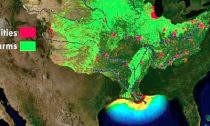
A near record-size “dead zone” of oxygen-starved water could form in the Gulf of Mexico this summer, threatening its huge stocks of marine life, researchers said.
The area could spread over 8,700 square miles, scientists at Louisiana State University said Monday. That’s about the size of the state of Massachusetts. It’s also well above the five-year average of 5,770 square miles.
Experts blamed unusually high rainfall across the Midwest this spring that washed farm fertilizers along streams and rivers through the Mississippi River basin into the gulf.
The nutrients in the fertilizers feed algae that die, decompose and deplete the water of oxygen, the Louisiana scientists said.
“When the oxygen is below two parts per million, any shrimp, crabs and fish that can swim away, will swim away,” Louisiana State University ocean ecologist Nancy Rabalais told the National Geographic magazine. “The animals in the sediment [that can’t swim away] can be close to annihilated.”
The problem might get even worse if any more significant tropical storms wash out more farm-fed nutrients, the scientists said.
Sewage runoff, caused by the spring floods, also add to the problem, National Geographic reported.
Scientists with the National Oceanic and Atmospheric Administration (NOAA) predicted a slightly smaller 7,829 square-mile spread. The record — 8,776 square miles — was set in 2017.
“A major factor contributing to the large dead zone this year is the abnormally high amount of spring rainfall in many parts of the Mississippi River watershed,” the agency said in its annual “dead zone” forecast.
A solution would be to keep fertilizer and sewage runoff from getting into the rivers, NOAA said.
A Mississippi River/Gulf of Mexico Watershed Nutrient Task Force has been monitoring the problem and has set goals to reduce runoff.















Social Profiles